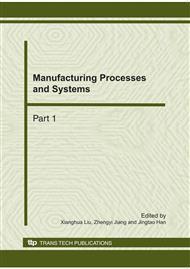p.363
p.368
p.372
p.377
p.385
p.389
p.395
p.399
p.406
Effects of Hydrogen on Machinability of BT25y Alloy
Abstract:
Effects of hydrogen on machinability involving cutting force, surface roughness and chips morphology of BT25y alloy with semi finish machining were carried out. The microstructures and phase composition of different concentrations were studyed by metallurgical microscopy, transmission electron microscope (TEM), and X-ray diffractions (XRD). The results show that existing a optimum hydrogen concentration (0.20wt.%) for machinability of BT25y alloy in which cutting force decreases 179N and surface roughness reduces about 24%, in addition, chips morphology are transferred from continuous to segmental. The grain refinement, hydride precipitations and thermal conductivity resulting from hydrogen can improve the machinability of BT25y alloy.
Info:
Periodical:
Pages:
385-388
Citation:
Online since:
October 2010
Authors:
Keywords:
Price:
Сopyright:
© 2011 Trans Tech Publications Ltd. All Rights Reserved
Share:
Citation:


